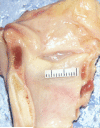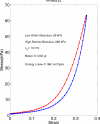Measurement of vocal folds elastic properties for continuum modeling
- PMID: 22921299
- PMCID: PMC3508138
- DOI: 10.1016/j.jvoice.2012.04.010
Measurement of vocal folds elastic properties for continuum modeling
Abstract
Objective: This study aimed to quantify the major elastic properties of human vocal fold's lamina propria, including longitudinal and transverse Young's modulus, shear modulus, and Poisson's ratio.
Methods: Samples were obtained from cadaveric human larynges that were snap frozen within 48 hours postmortem and kept at -82°F and thawed overnight in saline solution. Once the sample was tested in the longitudinal direction, two special brackets were glued to the side of each sample and the sample was mounted with brackets in the transverse direction. The shear modulus was obtained from samples mounted between two parallel plates applying shear forces. The Poisson ratio was obtained using high-speed video imaging of two-dimensional samples with markers for longitudinal and transverse strain measurements.
Results: Results indicate that human vocal fold elasticity is very nonlinear with slope that increases 10-15 times from low- to high-strain values. Its average low-strain Young's modulus is approximately 30 kPa in the longitudinal direction and 1 kPa in the transverse direction. The vocal fold longitudinal shear modulus is in the same order of magnitude of its transverse shear modulus (less than 1 kPa). The average Poisson ratio is approximately 0.57.
Conclusions: The present study provides quantitative data for the longitudinal and transverse elastic properties of the human vocal fold tissue and indicates that nonlinear behavior and relative difference of these properties may lead to wide ranges of oscillation frequency and amplitude in human larynges.
Copyright © 2012 The Voice Foundation. Published by Mosby, Inc. All rights reserved.
Figures










References
-
- Alipour F, Berry DA, Titze IR. A finite element model of vocal fold vibration. J Acoust Soc Am. 2000;108:3003–3012. - PubMed
-
- Rosa MO, Pereira JC, Grellet M, Alwan A. A contribution to simulating a three-dimensional larynx model using the finite element method. J Acoust Soc Am. 2003;114(5):2893–2905. - PubMed
-
- Lekhnitskii SG. Theory of Elasticity of an Anisotropic Body. Mir Publisher; Moscow: 1981.
-
- Perlman AL, Titze IR, Cooper DS. Elasticity of Canine Vocal Fold Tissue. J Speech Hear Res. 1984;27(2):212–219. - PubMed
-
- Alipour F, Titze IR. Elastic Models of Vocal Fold Tissues. J Acoust Soc Am. 1991;90(3):1326–1331. - PubMed
Publication types
MeSH terms
Grants and funding
LinkOut - more resources
Full Text Sources
Other Literature Sources

